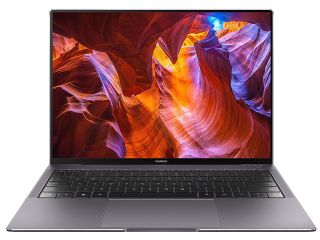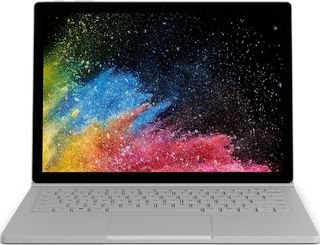Tom's Hardware Verdict
Apple’s 2018 MacBook Pro refresh offers strong CPU performance and blazing fast SSDs worthy of the Pro name, but it could use longer battery life and is still short on ports.
Pros
- +
Strong CPU performance
- +
Ridiculously fast SSD
- +
True Tone display
- +
Quieter keyboard
Cons
- -
Battery life shorter than competition
- -
Still short on ports
- -
Only expensive models refreshed
Why you can trust Tom's Hardware
Dual-core processors just aren’t enough for real professionals anymore. Graphics work, video editing and photo manipulation require more power than ever. And while Apple caught flack for a lack of power in the 13-inch MacBook Pro last year, the company’s update to quad-core chips packs a punch. The Core i7-8559U on our review config was speedy, and the laptop also features some of the fastest SSD storage we’ve ever seen. Additionally, it offers some features from the iPad, like True Tone and “Hey Siri,” for the first time on the Mac. But the design hasn’t changed, so if you’re not a fan of low travel keyboards and don’t want to live the dongle life with only Thunderbolt 3 ports, it still has shortcomings.
Design
The 2018 refresh of the MacBook Pro doesn’t change the laptop’s aesthetics. It’s identical to the 2017 model with its slim design and strong build quality unlike almost any other manufacturer in the laptop space. Our review unit came in space gray, which remains my favorite shade Apple has ever produced, but it also comes in silver.

There are some downsides to keeping the same design. The bezels around the 13.3-inch, 2,560 x 1,440 retina display are thicker than on some competing notebooks — notably, Dell’s XPS line.
The island-style keyboard is flanked by two speaker grilles with a spacious touchpad below and, above, the Touch Bar, including the Touch ID fingerprint reader to sign in and to make payments with Apple Pay.



Apple’s decision to rely exclusively on Thunderbolt 3 ports is less polarizing than it was a year ago. Other notebook makers, like Dell with its XPS 13, are slowly starting to follow suit (but at least that notebook has a microSD card reader). Still, the total of four Thunderbolt 3 ports, two on each side of the laptop, still necessitates the use of dongles for older hard drives, memory cards and monitors. An SD card reader would have been a nice addition.

Weighing in at 3 pounds and 12 x 8.4 x 0.6 inches, the MacBook Pro doesn’t have the same size advantage it used to over some Windows PCs. The Dell XPS 13 is slighter in every way at 12 x 8 x 0.5 inches and 2.7 pounds, and the Huawei MateBook X Pro, essentially a copycat of Apple’s design, is 2.9 pounds and 12 x 8.5 x 0.6 inches. Microsoft's creative-oriented 13-inch Surface Book 2, however, is a heavier 3.6 pounds and 12.3 x 9.1 x 0.9 inches.
Specifications
| Display | 13.3-inch, 2,560 x 1,600 IPS retina display with True Tone |
| CPU | Intel Core i7-8559U |
| Graphics | Intel Iris Plus Graphics 655 |
| Memory | 16GB 2,133MHz LPDDR3 |
| SSD | 2TB SSD |
| Optical | ✗ |
| Networking | 802.11ac, Bluetooth 5.0 |
| Ports | (4) Thunderbolt 3 |
| Audio | Stereo speakers, Headphone/microphone combo jack |
| Camera | 720p FaceTime webcam |
| Battery | 58 Wh |
| Power Adapter | 61W |
| Operating System | macOS High Sierra (10.13.x) |
| Dimensions (WxDxH) | 12 x 8.4 x 0.6 inches |
| Weight | 3 pounds |
| Other | Touch Bar with Touch ID Sensor, T2 chip |
| Price (as configured) | $3,699 |
Performance
Our review configuration of the new MacBook Pro used an Intel Core i7-8559U with a 2.7GHz base clock and Turbo up to 4.5 GHz, 16GB of 2,133MHz LPDDR3 RAM, Intel Iris Plus 655 graphics and 2TB of SSD storage. That means that a light workload with 25 Chrome tabs, one of which was streaming a 1080p episode of The Daily Show with Trevor Noah, was no problem for it.

On the Geekbench 4 overall performance test, the MacBook Pro smoked the competition. It earned a score of 17,348, surpassing the premium laptop category average (11,507), Surface Book 2, MateBook X Pro and XPS 13.

With our standard file transfer test, copying 4.97GB of mixed-media files was almost instantaneous. So we turned to the Blackmagic Disk Speed Test, which measured speeds of 2,519Mbps. That’s the fastest I’ve ever seen and puts the premium laptop average (350MBps) to shame. It’s like it finished a race before the XPS, MateBook and Surface had time to start.
Those speed tests could be attributed to several factors. For one, Apple’s APFS file system is incredibly quick and can clone files with minimal amounts of data from the original. It also calculates data in a way that may make read speeds faster. Additionally, Apple’s T2 chip, which is showing up for the first time in a MacBook Pro here, serves as the SSD controller and could be working some other technical magic.

The MacBook Pro took 1 minute and 16 seconds to complete our Excel macro test, in which notebooks pair 65,000 names and addresses. That’s faster than the average, as well as the MateBook and the Surface. Only the XPS was faster.
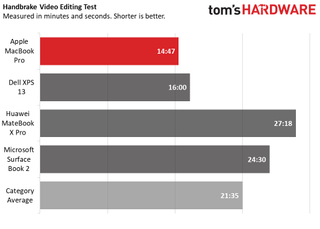
On our Handbrake video editing test, the MacBook Pro transcoded a 4K video to 1080p in 14 minutes and 47 seconds,again far ahead of the average (21:35) and besting all of the competition.
Throttling? Not a Problem
To see how well the MacBook Pro 13-inch handles lengthy intensive tasks that heat up the CPU, I did a real-world video editing test. In Final Cut Pro X, I uploaded a 4K video I shot on my iPhone and added a soundtrack with some open-source audio. I added a bunch of transitions and exported my project as a 4K video.

You don't need to worry about CPU throttling. During that time-consuming export, the average clock speed was just under 3GHz (0.3 above base), according to the Intel Power Gadget. That’s not to say it never ran below base clock speed, because it did for a few seconds at a time, but usually that meant that the Intel Iris Plus graphics were taking over in the rendering and exporting process. The CPU ran at an average temperature of 87 degrees Celsius (188.6 degrees Fahrenheit).

I ran Cinebench’s CPU test five times on the MacBook Pro and its competitors, and Apple's offering not only offered higher scores than competitors, but also stayed relatively steady. While the MacBook Pro 15-inch launched with some throttling issues, on the 13-inch machine, it’s safe to consider them solved.
The Iris Plus Graphics, however, were outclassed by those in other devices. On the Dirt 3 gaming test, the MacBook Pro ran at 47 frames per second (fps), below the 69-fps average and the Surface Book 2 and Huawei Mate Book X Pro's scores.
Display
The 13.3-inch, 2,560 x 1,600 IPS display on the MacBook Pro is bright and vivid. This is the first time Apple’s True Tone tech, which adjusts the color temperature of the display based on the ambient lighting in the environment, has come to a laptop. It definitely looks great, but I spent the majority of my testing with it off. After all, professionals editing photos and videos need to know exactly which colors they’re working.
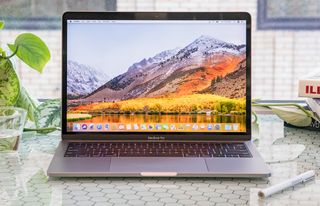
When I watched a 1080p trailer for Aquaman with True Tone on, Hera’s unnaturally red hair popped against the walls of a sandy cave, and the blues and oranges in a battle between sea creatures and fire monsters was extremely vibrant.

The screen measured an average of 327 nits of brightness on our light meter, surpassing the premium laptop category average of 307 nits, but falling below the Surface Book 2, MateBook X Pro and both the 1080p and 4K variants of the XPS 13.
It covers 125.3 percent of the sRGB color gamut, surpassing the average (111 percent), 1080p XPS 13 (117 percent) and MateBook Pro X (124 percent). Both the 4K XPS 13 and the Surface reached 130 percent.
Comparison Products
Keyboard, Touchpad and Touch Bar
The keyboard is likely the most polarizing part of the MacBook Pro.
Apple’s low-travel keyboard, with just 0.5 millimeters of travel, requires 61 grams to actuate. On the 10fastfingers.com typing test, I reached 113 words per minute, which is my high end, with my usual 2 percent error rate. While we usually prefer systems with at least 1.5 millimeters of travel, I didn't find the lack of travel to be uncomfortable.

While I’m OK with the keyboard, Apple faithfuls on the internet, tech enthusiasts, as well as some of my colleagues have vocally disagreed with me for the past few years. This keyboard won’t change their minds. The only thing that has changed, according to Apple, is that it’s quieter, and that seems about right. The clicking is more muted than on last year’s model, though you can still hear it if you type hard enough.
What we don’t know for sure is if the keyboard is more reliable than the ones on models dating back to 2015 and for which Apple now has a replacement program. But iFixIt’s teardown of the machine revealed a silicone membrane around the switches. Leaked documents and a patent from March suggest this membrane could block dirt and dust from getting into the keyboard, but no one has said anything about it officially.
The 5.2 x 3.2-inch touchpad is spacious, and like models going back several years now, doesn’t actually click. Instead, it uses haptic feedback to simulate the feeling that you’re pushing down. I never once had an issue with a gesture, like swiping between Spaces with four fingers, pinching out with five fingers to reveal the desktop, or two-finger scrolling.
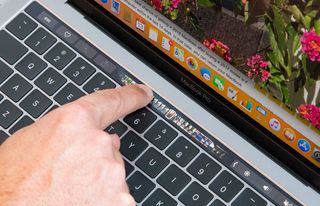
The OLED Touch Bar on top of the keyboard is only as strong as its developer support. And right now, I don’t feel that there’s enough developer support to make it a must-have (except for the fact that to get the latest CPU, you need to get a MacBook Pro with one). I’ve grown to accept the Touch Bar (and definitely appreciate having Touch ID attached), and scrubbing through video with it is cool, but I still prefer the dedicated function keys.
T2 Chip
The new generation of MacBook Pros are the first to feature Apple’s T2 chip, which takes on some capabilities from the CPU. It uses Apple’s secure enclave co-processing technology for encryption and secure booting and also serves as the SSD controller. Additionally, it allows these laptops to use the “Hey Siri” command to summon Apple’s digital assistant. I don’t use Siri a lot on the Mac, but it brings the laptops up to par with the iPhone and iPad in terms of using the assistant.
Audio
Considering how thin the MacBook Pro is, the speakers on either side of the keyboard are impressive. When I listened to P!nk’s “Raise Your Glass,” the vocals, keyboard and guitars were clear, and the drums really pounded. I wish the bass stood out a little more, but the music easily filled our mid-sized conference room.
Upgradeability
There are five pentalobe screws on the bottom of the MacBook Pro, but the laptop isn’t designed to be user upgradeable. While most laptops have the CPU soldered to the motherboard, Apple has also attached the storage and RAM directly to the board. If you think you’ll need extra RAM or storage, you should get it when you first order the notebook. (Of course, you can always add more external storage via Thunderbolt 3).
Battery Life

You’ll likely be able to get a day’s worth of productivity work out of the MacBook Pro. Its 58 Wh battery endured for 8 hours and 44 minutes on our battery test, which continuously browses the web, streams videos and runs graphics tests at 150 nits of average brightness. That’s higher than the average for premium laptops (8:26), but the XPS 13 outperformed, running just shy of 12 hours on a charge with a lesser 1080p display and 8:23 with a 4K screen. The MateBook Pro lasted a little more than an hour longer.
Heat
The MacBook Pro won’t get too hot to use on your lap. After 15 minutes of streaming HD video, the bottom measured 35.6 degrees Celsius (96 degrees Fahrenheit), the center of the keyboard hit 32.8 degrees Celsius (91 degrees Fahrenheit) and the touchpad was a cool 30 degrees Celsius (86 degrees Fahrenheit).
Webcam
Apple’s 720p FaceTime camera is sufficient for video chatting for work and with family. It’s clear and color accurate. A picture I took of myself in the Photo Booth app showed every individual hair in my beard and caught my dimple. The blue checks in my shirt were well-defined and didn’t bleed into the white square. The light coming in from some nearby windows was slightly blown out, though.
macOS, Software and Warranty
Some people buy Apple machines because of the company’s dedication to well-designed hardware, but professionals are going to get this notebook because of macOS. The MacBook Pro comes running macOS High Sierra (10.13) and will be eligible to upgrade to macOS Mojave (10.14) later this year.
Apple’s free software includes its iWork suite: Pages, Numbers and Keynote, as well as iMovie for basic video editing, GarageBand for music editing and, of course, Apple stalwart Messages, which lets you send iMessages and texts from your iPhone. Many of these sync with iCloud, making it seamless to retrieve files on your other Apple devices.
Apple sells the MacBook Pro with a 1-year warranty and 90 days of free technical support. Warranty and technical support can be increased to three years with AppleCare+ ($269).

Configurations
Our 13-inch MacBook Pro review unit came maxed out with a 2.7GHz Intel Core i7-8559U, Intel Iris Plus 655 graphics, 2TB of SSD storage and 16GB of LPDDR3 RAM. That costs $3,699, most of which is attributed to the additional storage.
The cheapest of the new MacBook Pros with Touch Bar is $1,799, with a 2.4GHz, 8th generation Intel Core i5 CPU, Iris Plus 655 graphics, 8GB of RAM and 256GB of storage.
Apple still sells MacBook Pros with dual-core, 7th generation Intel Core i5 and i7 processors without the Touch Bar and with just two Thunderbolt 3 ports. Those start at $1,299 but were not upgraded this year. For casual users who aren’t editing photos and videos, however, they will likely be sufficient.
Bottom Line
Apple’s refreshed 13-inch MacBook Pros delivers a significant boost in power over the last generation, with 8th generation Core processors and the fastest SSD speeds I have ever seen. The True Tone display option is nice, but you’ll want to turn it off while doing creative work. Battery life, however, is shorter than competing Windows systems, and if you don’t like using adapters, the four Thunderbolt 3 ports might be the bane of your existence. And if you do to a price comparison, you'll find you have to pay a fair amount more for Apple’s device if you add a lot of storage.
If you want to use macOS and its ecosystem of apps, there really isn’t a competitor to recommend. But if you’re flexible and willing to try Windows, the Huawei MateBook X Pro with a design that apes Apple's, can be had for $1,599 with an Intel Core i7-8550U processor, a 3,000 x 2,000 display and discrete Nvidia GeForce MX150 graphics. That price includes a 512GB NVMe PCIe SSD, so you can’t get as much internal storage as Apple offers (and it sure won’t be as fast as the MacBook Pro).
Dell’s XPS 13 does much better on battery life, but only with a 1080p display. A $1,649.99 configuration with a 512GB PCIe SSD, 16GB of RAM and Intel Core i7-8550U will likely last longer, but getting more internal storage forces you to a 4K touch screen without the extra endurance. Still, loading it up with 2TB of storage is cheaper than the MacBook at $2,659.99, though with lesser UHD Graphics 620.
Apple has proven with this machine that yes, the MacBook Pro can be for an actual pro. It would do well to use a discrete GPU like Huawei does, and the battery life can be improved. But if macOS is your preferred ecosystem and you’re willing to pay up, this refresh brings the power a high-end ultraportable should.
MORE: Best Gaming Laptops
MORE: Gaming Laptop Previews
MORE: All Laptop Content
Andrew E. Freedman is a senior editor at Tom's Hardware focusing on laptops, desktops and gaming. He also keeps up with the latest news. A lover of all things gaming and tech, his previous work has shown up in Tom's Guide, Laptop Mag, Kotaku, PCMag and Complex, among others. Follow him on Threads @FreedmanAE and Mastodon @FreedmanAE.mastodon.social.

First in-depth look at Elon Musk's 100,000 GPU AI cluster — xAI Colossus reveals its secrets

Now is a great time to pick up an Nvidia RTX 4070 12GB graphics card — back down to its lowest-ever price

Lenovo Legion Go now down to just $499 — 8.8-inch behemoth undercuts Asus ROG Ally X and Valve Steam Deck OLED
-
bananaforscale It doesn't throttle because it doesn't have an i9, and even with the current CPU it's close. "The CPU ran at an average temperature of 87 degrees Celsius (188.6 degrees Fahrenheit)."Reply -
TJ Hooker It'd be nice to know the hardware configurations of the other laptops tested. I only checked out the XPS 13, but it has a variety of options including CPU, RAM size/speed, SATA vs PCIe storage, etc.Reply -
Kelavarus Reply21195186 said:It'd be nice to know the hardware configurations of the other laptops tested. I only checked out the XPS 13, but it has a variety of options including CPU, RAM size/speed, SATA vs PCIe storage, etc.
This is exactly what I was going to say. Makes it kind of confusing. I was going to say a lot more in specifics, but decided to do some digging, and holy cow. I was confused because the Surface Book 2 gets such a low score on Geekbench 4 compared to the MBP, and the SB2 is equipped with (judging by the score) an i7-8650u, while the MBP has an i7-8559u. I would have assumed the higher number i7 should be better, right? Especially as they both start with 8, so the same generation right? Buuuut apparently Intel makes no sense when it comes to naming conventions and the 8559u is Coffee Lake and has a higher TDP than the Kaby Lake 8650u. Ooookay, Intel. Not confusing at all.
I am still curious though about the very large gap. Seems unlikely it's all CPU, and the SB2 should be equipped with at least a GTX 1050, so is that T2 chip working some magical wizardy on the benchmark? -
TJ Hooker @Kelavarus yeah as a consumer there's little you can glean about an Intel CPU just based on its model number (other than generation), at least as far as I can tell. As you noticed, the 8559u has a higher TDP, and higher base/boost clocks compared to the 8650u. Also, the 8559u is coffee lake, whereas the 8650u is Kaby Lake refresh. Confused yet? :PReply
I'm guessing the geekbench scores are purely the CPU results (from what I can find it looks like Geekbench 4 has separate compute workload test to test GPU performance). -
owhansson Something smells fishy. When I see scores like the one in your benchmarks, I cannot help but wonder how it was achieved. And then I look for explanations.Reply
I love Tom's because most articles are somewhat analytical. Some articles, by certain contributors, are very analytical. They are interesting and usually answer most of my questions. This article, instead, avoids even asking the most obvious question: How was the storage performance achieved?
As I see it, there are three possible reasons for the very high score -
1. We have ourselves a huge breakthrough in storage technology that the rest of the industry has somehow missed (highly unlikely) or,
2. Apple is utilizing Intel Optane and hasn't told us (unlikely) or,
3. The true performance of the SSD is being hidden by Copy-on-Write (likely).
I would like to know which one it is. Most of all, I would like a review on Tom's to NOT just buy into the hype and instead investigate the issue. -
TJ Hooker @owhansson my best guess is that the storage benchmark used is basically reporting max sequential read speeds, in which case the results are about on par with other premium PCIe SSDs. It appears all the other laptops tested were configured with SATA SSDs, making the comparison a poor one.Reply
It's also possible your option # 3 is coming into play, in the form of Apple's new "Instant Clone" file system feature. -
rr8086 I don't understand why you would recommend Huwaei products when the FBI, NSA, and CIA and other security agencies have all urged people not to buy their products. They're considered a national security risk.Reply -
TEAMSWITCHER Reply21195410 said:Something smells fishy. When I see scores like the one in your benchmarks, I cannot help but wonder how it was achieved. And then I look for explanations.
I love Tom's because most articles are somewhat analytical. Some articles, by certain contributors, are very analytical. They are interesting and usually answer most of my questions. This article, instead, avoids even asking the most obvious question: How was the storage performance achieved?
As I see it, there are three possible reasons for the very high score -
1. We have ourselves a huge breakthrough in storage technology that the rest of the industry has somehow missed (highly unlikely) or,
2. Apple is utilizing Intel Optane and hasn't told us (unlikely) or,
3. The true performance of the SSD is being hidden by Copy-on-Write (likely).
I would like to know which one it is. Most of all, I would like a review on Tom's to NOT just buy into the hype and instead investigate the issue.
The answer to your question is #1. With High Sierra, Apple introduced a new file system that is dramatically faster at certain operations (i.e. copying files) than the previous HFS+ file system, or even Microsoft NTFS. Files are not actually copied, new file descriptors are added with back pointers to the original file and modifications are stored as deltas. That is not to say that Apple SSD controllers are not fast .. they are. But in this test, it's AppleFS that is doing most of the "magic" here. -
bortao Why there's no specs of the comparing products?Reply
Why there's no comparison to last year's mbp? or to a 15" model?
File transfer benchmark is invalid, because what AppleFS do is a simple clone, not sector by sector copy, so this do not measure the hard drive speed.
This processor's turbo is 4.5Ghz. In your "real-world video editing test" you just mention the base 3.0Ghz. So I assume it is indeed throttled down (to the base clock), and couldn't achieve turbo speed. So your headling "Throttling? Not a Problem" is incorrect. -
lew_zealand 4.5 GHz is a single core Turbo number and video editing is a multi-core workload so you'll need to see what the all core Turbo mode is.Reply
Additionally, all laptops throttle below maximum turbo when all cores are used, thin and light laptops more so. The Macbooks are no exceptions and neither are Dell, Lenovo, etc. The differences are in the cooling hardware for each. I'd love to see a comparo of the same CPUs across different manufacturers to see who is doing the best job of cooling in a thin and light laptop.


